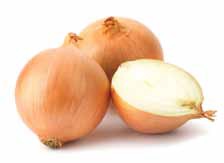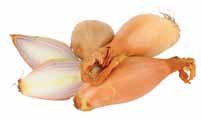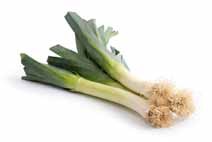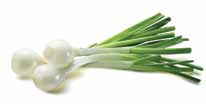
| What is Flavor and Fortune? |
| How do I subscribe? |
| How do I get past issues? |
| How do I advertise? |
| How do I contact the editor? |
Read 13193444 times
Connect me to:
| Home |
| Articles |
| Book reviews |
| Letters to the Editor |
| Newmans News and Notes |
| Recipes |
| Restaurant reviews |
| Article Index (all years, slow) |
| List of Article Years |
| Article Index (2026) |
| Article Index (last 2 years) |
| Things others say |
| Related Links |
| Log In... |
| Authors |
| Categories & Topics |
Onions and Some Relatives
| by Jacqueline M. Newman |
Vegetables and Vegetarian Foods
Winter Volume: 2017 Issue: 24(4) pages: 18 to 21
 Onions
are in the
Allium family
and botanically
called Allium
cepa. They
are related to
garlic, shallots,
and leeks,
among other
items. Already
discussed in
Volume 23(2) on pages 16 - 19 and 24, they can be
biennials or perennials, most harvested in the Fall. If
they are left in the ground, they will grow bigger and
better the following spring.
Onions
are in the
Allium family
and botanically
called Allium
cepa. They
are related to
garlic, shallots,
and leeks,
among other
items. Already
discussed in
Volume 23(2) on pages 16 - 19 and 24, they can be
biennials or perennials, most harvested in the Fall. If
they are left in the ground, they will grow bigger and
better the following spring.
They are bulbs bred and grown in China for some seven thousand years. The Chinese call them yang cong meaning ‘foreign’ even though they have been around that long. Some call them ‘jade onions’ no matter their color, size, or variety. All varieties are popular in the Chinese culinary if consumed for health as medicinals or as vegetables.
Green onion tops are erroneously called their stalks. They die back in Fall and reappear the following spring, if left in the ground and not removed. They were first described in the western world in 1753 by Carl Linnaeus. Their red cousins share the same tan exterior as do white ones and all in this family, no matter the color of their flesh, are eighty-nine percent water, four percent sugar, one percent protein, and two percent fiber.
For those with pets, we recommend not letting them in house or garden because if cats or dogs ingest them, they can get sick because too much or too many can be toxic for them. On the positive side, they can repel moths and prevent small insect bites if made into a poultice for the skin. They have been used as such and in other medicinal ways for almost as long as they have been around thanks to their cinnanic acid, caffeine, asafoetida, volatile oils, and other stomach-bothering constituents.
Chinese TCM practitioners say they have a warm, sweet yet pungent nature and can positively impact liver and lung channels. They are not always nice when slicing or dicing as they can bring tears to the eyes. Do that task under cold running water to reduce their tearing impact.
The Chinese use onions to treat high blood pressure, relieve constipation, reduce skin ulcers, treat wounds, stop vaginal itching, and reduce other irritations. In the kitchen, use them in major and minor dishes where they are always appreciated.
 Shallots,
relatives of onions,
often grow in
bunches, have tan
exteriors as do
onions, and can be
white or red within.
Their bunches
are almost always
called clusters, their bulbs a type of Allium cepe that
is different from their brethren. Many originated in
Central Asia, others in China, and they are preferred
when fried and crisp. They can be purchased that way.
Chinese cook them at least until they wilt though they
prefer them crisp, and they do like to mix them with
other ingredients.
Shallots,
relatives of onions,
often grow in
bunches, have tan
exteriors as do
onions, and can be
white or red within.
Their bunches
are almost always
called clusters, their bulbs a type of Allium cepe that
is different from their brethren. Many originated in
Central Asia, others in China, and they are preferred
when fried and crisp. They can be purchased that way.
Chinese cook them at least until they wilt though they
prefer them crisp, and they do like to mix them with
other ingredients.
In China, the word for shallots varies by region. It can be yang cong, jiu cong, or qing cong; onions are most often called yang cong. The recipes that follow when cooking them, substituting one for the other is common and acceptable. Our Chinese friends tell us they rarely do that but we often do, particularly when one is unavailable.
Reasons differ, but these friends tell us they do respect taste and their textural differences. They sense these changes but this does not bother many of them. If it bothers you, simply do not do that. We suggest you do as you like for all these bulbs.
 Leeks are
also related,
and botanically
called Allium
ampeloprasom.
In the past, they
were called
kurrats. They
are the mildest
members of this
family, and even though they are, Buddhist monks
do not eat them because they believe they raise their
sexual energies. Actually, they do not eat any allium
bulb for this reason.
Leeks are
also related,
and botanically
called Allium
ampeloprasom.
In the past, they
were called
kurrats. They
are the mildest
members of this
family, and even though they are, Buddhist monks
do not eat them because they believe they raise their
sexual energies. Actually, they do not eat any allium
bulb for this reason.
This family member is the tallest and most layered among them. They also hold the most dirt and sand in their green tops so do wash them carefully. Often sold in bunches though they do not grow that way, we use leeks very carefully rinsed to get rid of all dirt or sand in their interiors. Sometimes, we cut them in half the long way and then rinse them.
 Scallions
are white in their
lower part which is
less than half way
up, green in their
upper parts, as are
leeks. When planted
and after sprouting,
most growers pile up the soil around their bottom part
trying to keep most of this section white; the more
white the better. Some users do discard the green part
and only use the white part as this is more tender and
has a different taste. Those that do, like them with as
much white as possible, while those that use the green
tops do want them as tall and as tender as possible.
Scallions
are white in their
lower part which is
less than half way
up, green in their
upper parts, as are
leeks. When planted
and after sprouting,
most growers pile up the soil around their bottom part
trying to keep most of this section white; the more
white the better. Some users do discard the green part
and only use the white part as this is more tender and
has a different taste. Those that do, like them with as
much white as possible, while those that use the green
tops do want them as tall and as tender as possible.
The Chinese and others who discard the green tops do save them if they plan to use them in soups and long-long-cooked dishes. We consider that a waste, add them to salads and other dishes and never throw them out. We find uses for them, we do cook the green part separately and longer. We love scallions and leeks and are careful to cook their whites for a short time, the green parts for more time than most recipes do.
With long cooking, leeks retain their shape and texture better than scallions do. And we know that leeks are the mildest in this family. We like them and cook either one only for a little time so they have good texture. We know that many folk have no or less trouble digesting and tolerating them.
Overall, do enjoy the entire family and do make all the recipes below and those found in other places, too. We use any family member in any dish, be they stews or stir-fried ones.
| Leek Omelettes |
|---|
4 leeks, cut in half the long way, rinsed of all sand, then angle-cut in thin slivers
1. Set aside one tablespoon of the green slivered leeks,
and rest the rest of the leek pieces with the eggs.
|
| Goat and Onion Soup |
|---|
½ pound goat fillet, sliced thin, then cut into one-inch long pieces
1. Mix goat meat, soy sauce, rice wine, and sesame oil
with the salt, pepper, and cornstarch, and marinate it in
this for half an hour before draining and drying the meat
with paper towels. Reserve the marinade refrigerated
for another use. It will stay refrigerated for several days.
|
| Lamb, Leek and Other Greens |
|---|
1 pound lamb fillet, sliced thin
1. Mix meat, soy sauce, rice wine, and sesame oil. Then
add salt and pepper and cornstarch and marinate for half
an hour. Then drain and dry the meat with paper towels.
|
| Spareribs and Caramelized Ginger |
|---|
3 to four pounds spare ribs, chopped in individual one-inch pieces
1. Blanch the spare ribs for two minutes in boiling water,
then quickly rinse them in cool water.
|
| Pork Ribs With Scallops |
|---|
5 dried scallops, boiled for one hour, then drained and cooled, then tear them into very thin strips
1. Put pork ribs into one quart of boiling water and
simmer for one hour, then remove and set them aside.
|
| Shallot-Flavored Corn and Chick Peas |
|---|
6 shallots, peeled, minced, and deep-fried crisp
1. Mix the shallots, ground Sichuan peppercorns, sugar,
and scallion pieces, then add the cornstarch and the
mashed duck egg yolks and salt and mix them into the
corn and chick peas.
|
| Chicken, Leek, Scallions, and Noodles |
|---|
1 pound wide Chinese wheat or rice noodles, cooked in salted water until just tender, drained, rinsed, and chilled in cold water
1. Rinse the noodles in hot water, then drain them and
mix them with half the sesame oil.
|
| Mandarin Fish Stew |
|---|
2 pounds firm white-fleshed fish, skinless and boneless, cut into two-inch pieces
1. Mix fish pieces with the brown sugar, Siracha sauce,
and vegetable oil, and all other ingredients and set
aside for ten minutes.
|

Copyright © 1994-2026 by ISACC, all rights reserved
Address
3 Jefferson Ferry Drive
S. Setauket NY 11720